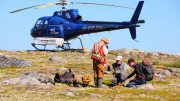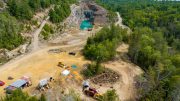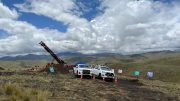As explorers continue to hunt for precious metals and critical minerals needed for the green energy transition, their pursuit takes them to every corner of the world. Here are eight companies advancing projects in the Americas, Australia, Africa and Europe.
Arizona Sonoran Copper
Arizona Sonoran Copper (TSX: ASCU: US-OTC: ASCUF) is advancing its flagship Cactus Mine project that sits on a 20.2-sq.-km property, about 70 km south of Phoenix, Ariz.
In December, the company signed a deal giving Nuton LLC, a Rio Tinto (LSE: RIO; ASX: RIO) subsidiary, an option to acquire up to 40% of the project in return for US$33 million in non-dilutive financing. The two will study the use of Nuton heap leach technologies at Cactus.
In a Dec. 14 press release, Arizona Sonoran president and CEO George Ogilvie said Nuton’s technology has “the potential to significantly increase copper cathode output from our current 45-to-50 kilotonne per annum target which could materially enhance project economics” and unlock “a previously stranded and untreatable mineral resource.”
A standalone Cactus pre-feasibility study for a 45,000 tonne-per-year heap leach and solvent-extraction/electrowinning operation is planned for this year’s first quarter, to be followed by an amended study in October that will include the recently optioned MainSpring property on the outskirts of Casa Grande, Ariz. A third study by year end will incorporate use of the Nuton technology. A feasibility study is planned for release in June 2025.
The company on Jan. 25 reported assay results from seven holes drilled last November at the MainSpring deposit. They included 321 metres of 0.2% total soluble copper from 45 metres depth, including 15 metres of 0.35% total soluble copper.
Arizona Sonoran acquired the project, previously known as the Sacaton mine, in July 2020 from Asarco, which operated the mine from 1972 to 1984. The project consists of a waste dump and three deposits – Cactus East, Cactus West and Parks/Salyer.
The project has an August 2023 total resource (in combined leachable and primary material) of 446 million measured and indicated tonnes grading 0.58% copper for 5.1 billion lb. and 234 million inferred tonnes grading 0.47% copper for 2.2 billion lb. Arizona Sonoran plans 54,860 metres of drilling at its MainSpring and Cactus West deposits this year, following 45,891 metres of drilling that was completed in 2023.
Infrastructure at the site includes electric power, access to water from a permitted industrial-use aquifer and proximity to a rail line.
Arizona Sonoran has a market capitalization of $152.7 million.
Filo Corp.
Filo Corp. (TSX: FIL; US-OTC: FLMMF), a Vancouver-based company and member of the Lundin Group, is continuing to drill its Filo del Sol copper project in Argentina’s San Juan province and the adjacent Atacama region of northern Chile. It’s planning a 40,000-metre program this year using nine drill rigs. The program follows more than 34,000 metres of drilling last year that was focused primarily on the project’s Aurora Zone.

A drill rig at Filo Corp’s Filo del Sol project in northern Argentina. Credit: Filo Corp
This year’s program will “step out from known zones of mineralization and test compelling new exploration targets,” said Filo president and CEO Jamie Beck in a December release. “With 11 target zones distributed across an area of 8 km north-south and 3 km east-west, we plan on testing the potential for Filo to be significantly larger than we currently know.”
Filo del Sol hosts a high-sulphidation epithermal copper-gold-silver deposit associated with a large porphyry copper-gold system.
In late January, Filo announced assay results from two drill holes, including 652 metres grading 0.81% copper equivalent from a depth of 492 metres and 1,298 metres grading 1.01% copper equivalent from a depth of 192 metres.
A February 2023 prefeasibility study for Filo del Sol estimated a US$1.3 billion after-tax net present value (NPV) at an 8% discount and an internal rate of return (IRR) of 20%. Initial capital costs are forecast at about US$1.8 billion, with sustaining costs of $140 million over a 13-year mine life.
The project hosts proven and probable reserves of 259.6 million tonnes grading 0.39% copper, 0.34 gram gold per tonne and 16 grams silver for 2.2 billion lb. copper, 2.8 million oz. gold and 133.3 million oz. Silver. Filo is well funded following a $130-million non-brokered private placement financing last June. In February 2022, the company announced an additional non-brokered private placement of $100 million by a subsidiary of BHP (ASX: BHP), which currently owns 6% of the company.
The Lundin Group won this year’s Thayer Lindsley Award from the Prospectors and Developers Association of Canada for its discoveries in the Vicuna district of Argentina and Chile, including Filo del Sol.
Filo Corp. has a market capitalization of $2.7 billion.
Global Lithium
Global Lithium (ASX: GL1) expects to complete a feasibility study for the 100%-owned Manna lithium project in Australia in the first half of this year.
The study will include an updated resource estimate, detailed mine schedule, metallurgical and process flowsheet test work results and detailed operating and capital costs. The updated resource will incorporate assay results from Global’s reverse-circulation and diamond drilling program last year, totalling 60,000 metres in 221 drill holes. Assay results from the drill program include 26 metres of 1.53% lithium oxide (Li2O) from 249 metres downhole and 17 metres of 1.80% Li2O from 32 metres.

Global Lithium’s Manna project in Western Australia. Credit: Global Lithium
The most recent resource for Manna, located 100 km east of Kalgoorlie in the Goldfields region of Western Australia, was released last July. The project hosts 20.2 million indicated tonnes grading 1.12% Li2O, and 15.8 million inferred tonnes at 1.14% Li2O, representing a 24.1% increase in total contained Li2O from 327,000 tonnes to 406,000 tonnes. The Manna pegmatite zone extends for 1.4 km along strike and is open in both directions, and has been tested to 450 metres depth.
A February 2023 scoping study released by the West Perth-based company estimated production of 2.2 million tonnes of spodumene concentrate over a 10-year mine life, a pre-tax net present value (at 8% discount rate) of A$2.8 billion and a pre-tax internal rate of return of 103%. Total capital costs are pegged at A$419.4 million.
In a Jan. 31 release, Global Lithium managing director Ron Mitchell reported the company is making progress on key environmental and native title approvals, to be followed by the grant of a mining lease. It’s also in discussions regarding offtake and partnering deals.
The feasibility study will examine the development and optimization of open pit mine designs and schedules, along with the assessment of potential underground mining scenarios.
Global Lithium’s portfolio also includes the Marble Bar lithium project located 150 km south-east of Port Hedland in Western Australia’s Pilbara region. Marble Bar’s Archer deposit, which comprises a swarm of spodumene bearing pegmatites, has a December 2022 upgraded mineral resource estimate of 18 million tonnes grading 1.0% Li2O.
Global Lithium has a market capitalization of A$130.1 million.
Goldsource Mines
Goldsource Mines (TSXV: GXS; US-OTC: GXSFF) holds the Eagle Mountain gold project in central Guyana, located in the Essequibo region, 325 km from the country’s capital, Georgetown. The property includes the Eagle Mountain and Salbora deposits.
Goldsource released a preliminary economic assessment (PEA) for Eagle Mountain on Jan. 16, projecting an after-tax internal rate of return (at 5% discount rate) of 57% and an after-tax net present value of US$292 million at a base case gold price of US$1,850 per ounce. The internal rate of return increases to 69% and the net present value grows to US$388 million at a gold price of US$2,055.
A two-phase open pit operation is envisioned, with the first phase focusing on production from low strip soft rock saprolite resources for the first 4.5 years, and the second phase targeting shallow and higher-grade fresh rock resources for an additional 10.5 years. Annual gold production is estimated at 66,500 oz. over the 15-year mine life.
The PEA is based on an April 2022 updated resource estimate of 31 million indicated tonnes grading 1.18 grams gold for 1,183,000 oz. and 18 million inferred tonnes grading 0.98 grams gold. Cut-off grades for the saprolite and fresh rock were 0.3 grams gold and 0.5 grams gold, respectively. The resource was based on 772 drill holes for 75,430 metres drilled up to Dec. 31, 2021.
The percentage of the resource lying within 50 metres from surface is 75% for the Eagle Mountain deposit and 58% for Salbora.
Development capex is estimated at US$95.6 million and $46.6 million for the first and second phases, respectively.
A 5,000-tonne-per-day processing plant would be upgraded in year five with conventional crushing and grinding equipment to treat a blend of fresh rock, transition rock and saprolite.
In December, Goldsource responded to Venezuela’s claims to Guyana’s Essequibo region, which are now before the International Court of Justice. Goldsource called the claims “widely discredited” and contrary to a definitive settlement of the boundary dispute by the same court in 1899.
Goldsource Mines has a market capitalization of $17 million.
Hercules Silver
Hercules Silver (TSXV: BIG; US-OTC: BADEF) is planning a 20,000-metre drill program to define the limits of its recent Leviathan copper porphyry system discovery at its Hercules silver-lead-zinc project in western Idaho.
The discovery was announced on Oct. 10, with hole HER-23-05 cutting 185.3 metres of 0.84% copper, 111 parts per million (ppm) molybdenum and 2.6 grams silver, including 45.3 metres of 1.94% copper, 104 ppm molybdenum and 8.2 grams silver.
The following month, Barrick Gold (TSX: ABX; NYSE: GOLD) invested $23.4 million in Hercules, through a non-brokered private placement. The gold major bought 21.3 units of Hercules (consisting of one share plus 0.32 of a share purchase warrant) for $1.10 apiece. The financing gave Barrick 12.3% of Hercules’ issued and outstanding shares on a non-diluted basis, and 15% on a partially diluted basis.
The two companies also entered into an investor’s rights agreement, granting Barrick certain participation and first refusal rights.
Barrick has seconded three geologists to Hercules Silver and provided access to their senior technical team to help with the interpretation of existing data and planning for the drill program.
Final assay results from the Hercules Silver’s 2023 drilling announced in January confirmed increasing copper grades to the north and west of the discovery hole. Hole HER-23-26 intercepted 460.8 metres of 0.4% copper, 74 ppm molybdenum and 1 gram silver per tonne, including 100 metres of 0.76% copper, 113 ppm molybdenum and 1.7 grams silver.
Step-out holes drilled in all directions from the discovery hole across an area of 450 by 500 metres have ended in mineralization.
Hercules Silver has a market capitalization of $205.1 million.
Ivanhoe Mines
Ivanhoe Mines (TSX: IVN; US-OTC: IVPAF) continues to make new discoveries in the Democratic Republic of Congo, where it also holds 39.6% of the large, high-grade Kamoa-Kakula copper complex.
The latest discovery, announced in November, was a high-grade copper discovery on its Western Foreland about 25 km west of Kamoa-Kakula. The Kitoko discovery is on 247 sq. km of newly acquired joint venture licences for which Ivanhoe has an initial 10% interest and a right to earn up to 60%.
The discovery hole returned 3.4 metres (true width) of 3.54% copper from 1,077 metres downhole. Another hole cut 3.1 metres of 3.67% copper from 1,118 metres and 5.2 metres of 11.64% copper from 1,135 metres. A 1% copper cut-off was used.
Also in November, Vancouver-based Ivanhoe announced an initial resource for its Makoko and Kiala deposits in the Western Foreland package, 5 km north and northwest of Kitoko. Makoko holds 16 million indicated tonnes grading 3.55% copper and 154 million inferred tonnes grading 1.97% copper at a 1.5% copper cut-off. Kiala hosts 5 million indicated tonnes grading 3.56% copper.
Makoko, first discovered in 2018, is about 20 km west of the Kakula deposit, along strike of the regional structure controlling high-grade copper mineralization at Kakula. High-grade copper mineralization has been outlined along a corridor that is 700 metres wide and at least 4 km in length.
On Dec. 18, Ivanhoe closed a $575-million private placement, which will allow it to quadruple its 2024 exploration budget to $90 million. This year’s budget will focus on Kitoko while also testing other targets in light of the new understanding of the regional geology resulting from the discovery.
According to the company, Kitoko highlights the potential for high-grade copper mineralization across a much greater area and within a wider variety of geological conditions than Ivanhoe previously understood.
Ivanhoe Mines has a market capitalization of $17.8 billion.
Minsud Resources
Minsud Resources (TSXV: MSR) is focused on its Chita Valley copper-polymetallic project in Argentina’s northern San Juan province.
In April, a subsidiary of South32 (ASX: S32; LSE: S32) is expected to assume a 50.1% interest in Minsud’s local subsidiary that owns the Chita Valley project. The two companies signed an earn-in agreement in November 2019, with South32 providing $14 million in return for the option. Now that South32 has exercised the option, Minsud won’t have to contribute funding until its partner has spent $42 million at the project.
Chita Valley hosts 33 million indicated tonnes grading 0.43% copper for 310.8 million lb., and 8.6 million inferred tonnes grading 0.40% for 75.4 million lb., plus traces of gold, silver and molybdenum, according to a 2018 resource estimate.
Minsud began exploring the property in 2008, produced an initial resource in 2015 and carried out a four-phase drilling program from 2018 to 2023. Results from 52 holes drilled in 2023 included 767 metres grading 0.25% copper, 0.05 gram gold and 4.91 grams silver from a depth of 154 metres. The interval included 18 metres grading 0.95% copper, 0.21 gram gold and 10.06 grams silver from 684 metres.
In other recent transactions, Minsud acquired the remaining 35% interest in the Minas de Pinto Trust for US$935,000, giving it 100% of the Minas de Pinto property, which forms part of Chita Valley. Minsud optioned the property in 2010, acquired a 50% interest in 2014 and a further 15% in 2020, paying a total of US$2 million since then.
Also, in January, Minsud transferred its La Rosita gold-silver project to an arm’s length acquirer in return for a 2.5% net smelter royalty.
Minsud Resources has a market capitalization of $164.1 million.
Pan Global Resources
Pan Global Resources (TSXV: PGZ; US-OTC: PGZFF) is a copper-focused company exploring its 100%-owned Escacena project in southern Spain’s Iberian Pyrite Belt.
Highlights from an 11-hole step-out drill program at the Canada Honda copper-gold discovery at Escacena were released in January.
Hole CHD09 cut 20 metres grading 1.09 grams gold from a depth of 154 metres, while hole CHD10 cut 5.6 metres of 1.15% copper from 150 metres. Hole CHD08 returned 6.8 metres of 1.48% copper, 0.65 gram gold and 7.2 grams silver from 203 metres.
Drilling of the Canada Honda target began in April 2023 to test a large gravity anomaly with assay results in June and September confirming it as a compelling high-priority target.
Vancouver-based Pan Global is also focused on the La Romana copper-tin-silver target at Escacena. Drill results released in January from nine holes at La Romana confirmed continuity of mineralization over 1.4 km and returned highlights including 9.7 metres of 1.6% copper.
Escacena covers an area of more than 57 sq. km adjacent to the Aznalcollar and Los Frailes projects owned by Grupo Mexico. First Quantum Minerals’ (TSX: FM) Cobre Las Cruces mine is 12 km to the east and Rio Tinto’s (NYSE: RIO; LSE: RIO, ASX: RIO) Atalaya mine is 23 km to the northeast.
Pan Global has been actively exploring Escacena since 2019 and has drilled more than 180 holes in the VMS-style deposit with 99% of them hitting mineralization.
In 2023, Pan Global completed 60 drill holes totalling 14,992 metres on five targets and completed preliminary metallurgy tests for La Romana confirming copper recoveries of up to 89.5%. It also expanded its portfolio of targets to more than a dozen following an extensive geophysics and geochemistry survey program.
Plans for 2024 include further drilling at its La Romana and Canada Honda targets, as well as additional metallurgical testing.
Pan Global’s property portfolio also includes the 16-sq.-km copper-gold Aguilas project in northern Andalucia.
The company has a market capitalization of $44.9 million.






Be the first to comment on "Global exploration snapshot: Eight companies seeking copper, precious metals and more"